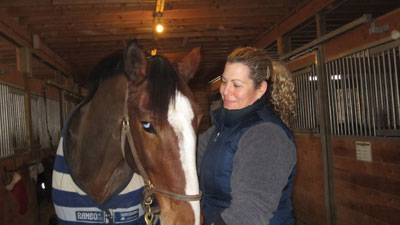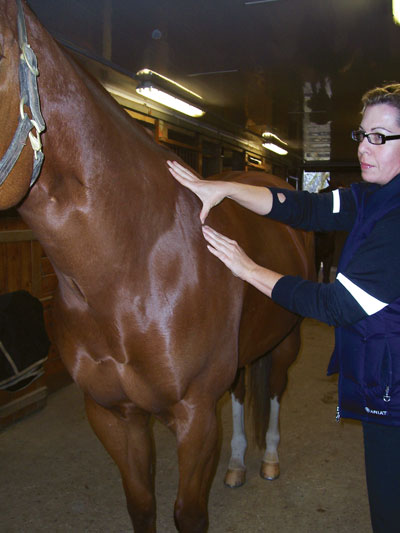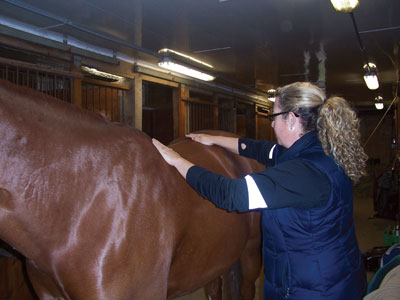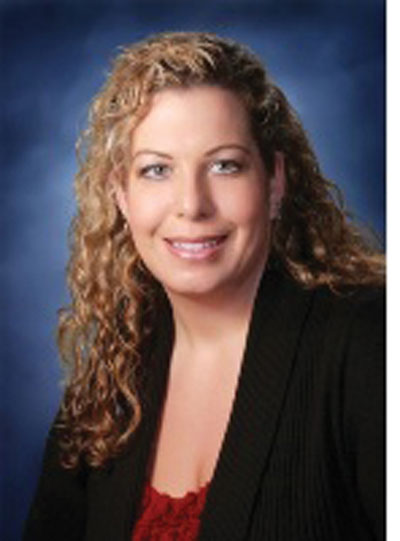
Features
Continuing Education
Education
A Horse of a Different Colour
Almost 15 years ago, I ventured into uncharted territory when I decided to become a Registered Equine Massage Therapist (REMT).
April 13, 2012 By Tracey A. Mitchell BA REMT
Almost 15 years ago, I ventured into uncharted territory when I decided to become a Registered Equine Massage Therapist (REMT). I have always had a passion for and an interest in horses. I guess you could say it was “infused” into my DNA from both sides of my family. For many years I competed in the sport of dressage and found inspiration, and a sense of peace, when spending time with horses.
 |
|
| Equine massage therapists work with horses of all disciplines.
|
In the fall of 1997, I made the decision to invest the following two years of my life into a solid education to become an REMT. It was a decision that left a lot of people (mainly my father) “concerned” for my future, given how unsure the equine industry can be, let alone starting off into a profession that was basically untouched! I admit, that being an equine massage therapist was a long stretch from becoming the lawyer I had always wanted to be since I was eight years old. But something told me that the “chance” I was taking was worth it and that I “had-what-it-would-take” to be successful in this field. Upon graduation in 1999, I combined my hard-earned education (which earned me the Award of Excellence) with my good people skills (so I have been told) and, making sure my tenacity was well intact, I started building my business!
Now, to be fair, I wasn’t the very first equine massage therapist to ever embark onto the equine “scene,” but I was definitely one of a very few at the time who was “armed” with a solid, professional knowledge of what the true essence of massage therapy was and how it should be practised. At the time of my graduation, there were individuals out there “massaging” horses with a very limited knowledge not only of what they were doing, but of the effects and serious consequences that could ensue if one is not properly trained.
To you RMTs out there, I am you – but just working on a different body. I know my principles and components; I can perform all of the Swedish massage techniques, recite the mechanical and reflex effects in my sleep, and have had the satisfaction of performing frictions on clients, assisting them back to full athletic function!
A multifaceted vocation
A few years ago, I realized that I am a “pioneer”! I am a new “breed” of massage therapist, literally unheard of, blazing the trails for those with the same training to follow.
With this realization, I have also assumed the responsibility of not only educating the practitioners of the future, but also horse owners, veterinarians and the public, of the importance and the possibilities of equine massage therapy. I travel to equine conferences and schools that offer equine studies. I perform webinars to speak about the field of equine massage therapy – i.e., what it is, what it takes to be an equine massage therapist, and the potential that this specialized profession has in the equine community.
For the general public, and massage therapists who work on humans, I tend to use the following timeline metaphor: At this moment, equine massage therapy is where human massage therapy was about eight years ago. Back when I first entered into my two years of education, equine massage therapy was where human massage therapy was about 16 to 18 yrs ago. It has been a long, hard road, with lots of speculation, and filled with doubters and disbelievers – and there is still a lot more work to be done.
Tips about the business
My business has very little overhead! The only things I require are a solid, reliable vehicle and good-sized step-stool for those taller clients. I do spend a lot of time in my car! My practice takes me all over Ontario, from Windsor up to north of Barrie and in and around the Greater Toronto Area. My clients will also invite me out to Alberta (Spruce Meadows show-jumping facility), Quebec and down to Florida (both Wellington and Ocala).
“Have car – will travel” is my motto, and I never turn a new client down. As massage therapists, we know how the ebb and flow of our clientele can be affected by such factors as the economy. I realize that, to most of my clients, I am a “luxury” for their “luxury.” This is always something I keep in the back of my mind – therefore, when clients call, I make sure I accommodate their needs.
The clientele
When I tell people what I do, a puzzled look tends to slide over their face. Nine times out of 10, I have to clarify, that “Yes, I massage horses”! The next question is whether or not the horse lies down for its massage. That answer is “No, due to a tool called the Passive Stay Apparatus, which allows the horse to sleep standing up.” The conversation then usually heads in the direction of what kind of horses do I work on? The average person, understandably, assumes that I work on mostly racehorses. However my clientele (the horses) includes a wide range of individuals from Standardbreds, to those in the Western disciplines (reigning, cutting, western pleasure and rodeo) and the English disciplines (hunter, dressage, jumping and eventing). I also have clients, whose sole job is that of a companion to their owner. I work with horses of all disciplines . . . and some stay closer to home than others.
The high-performance athlete
In the course of one’s career, it is good, every once in a while, to take an inventory as to the progress one has made and revisit the goals one still wishes to achieve. My hard work, endless hours of travel and sacrifices made have led me along an incredible road of experiences and successes that I am grateful for, and humbled by, every day.
 |
|
| Massage therapy is carried out with the client in standing position.
|
Over the years, I seem to have developed a niche among the show jumpers. Some of the horses that I have had the honour to work with have represented Canada in events such as the Olympics, Pan Am Games, World Equestrian Games, World Cups and Nations Cups. I have had the chance to work on these powerful horses, and to work with the select veterinarians, farriers (blacksmiths) and other health-care practitioners (equine chiropractors and acupuncturists) who have assisted in keeping them at the top of their international game. I have been an important component to the success of these horses; I have been a part of a team of professionals whose purpose was to support both horse and rider in their athletic endeavours, while representing our country. For that I am humbled and proud.
When I first started massaging the “high-performance athlete,” I was taken aback by the horses’ attitudes and mindsets. The disposition, focus and “air” about these horses are the equivalent to that of high-performance athletes of the “human kind” – they know their job, they know they are good at it, and they also know when it’s game day!
My job as their massage therapist is to keep their body supple and as pain-free as possible, and their minds sound and still wanting to do the task ahead of them. Just like the human athlete, these horses experience a lot of mental stressors. It’s quite safe to say that I’m a bit of a “sports psychologist” as well. Not only am I blessed to massage these amazing horses, but I also work for very reputable and professional horsemen and horsewomen. The people who compete atop these horses recognize how much massage therapy assists their equine partners, and they make sure that I am a part of their training program.
A call for high-quality, trained therapists
To date, the profession of equine massage therapy is not regulated. Anybody with a fleeting interest in massaging horses could simply read a book, watch a video on the subject, or take a four-day course and, then, proceed to charge the general horse-owning public to massage their companions and athletes of all levels! To me, this is a very scary concept and an unfortunate reality that I would like to see greatly reduced.
It is because of this possibility of horse owners receiving what I feel is substandard care that I am as passionate about the expectations that they should have regarding the quality of individual massaging their horse as I am about educating owners and trainers.
Horse owners need to know that REMTs practise with the same kind of standards of practice and code of ethics RMTs follow. They should expect a thorough case history and health history to be collected upon the initial visit, with ongoing clinical reports produced after every treatment session. Owners should expect a conformation (postural) assessment and a gait analysis to be performed on their horse. When the session is over, the owner should also expect to be given home-care suggestions – this should include everything from hydrotherapy to appropriate stretches.
Horse owners need to feel secure in their decision to utilize massage therapy in their horse’s health care!
Working with veterinarians
The one major aspect of equine massage therapy that is quite different from that of human massage therapy, is the level of relationship required between the REMT and the client’s primary health-care provider – the veterinarian.
 |
|
| Massage therapy on high-performance equine athletes supports both the horse and the rider in their collective endeavour.
|
In the world of equine health care, the only individual who is legally allowed to “treat” horses in any way is the overseeing veterinarian. And because of this, an REMT’s scope of practice is much more limited than that of an RMT. An REMT is not allowed to diagnose, perform any type of testing or make any suggestions as to what presenting signs and symptoms might indicate, as far as an injury or pathology is concerned. Doing any of the above could very easily result in being charged with practising veterinary medicine.
Due to these limitations, good communication skills are a strong prerequisite when massaging in the equine world. When a new client contacts me, I then notify the horse owner’s vet and inform them that one of his/her clients is interested in having me work on their horse. This is done not only out of respect for the role that the supervising vet holds in this horse’s life, but also as the first step to opening the lines of communication to ensure the horse’s overall good health care and that all parties are informed of any issues and possible contraindications to treatment.
Twelve years into my practice, I can honestly say, I have the same passion for my “job” as I did the day I started, if not more. I often chuckle to myself when I refer to what I do as a job, because it certainly doesn’t feel like a job, even at the end of a 14-hour day (that’s including travel time).
As a reflection of that, my practice continues to grow. With the growth comes a need for more hours in the day, and more days in the week, but I make it all work, and my clients now understand they have to book ahead. On average I may massage 12 to 20 horses a week, depending on the time of year, and on what upcoming competitive events or clinics the horses need to be ready for. Even near the end of a long day when my last client has been put in front of me for me to spend the next 60 to 75 minutes with, as soon as I lay my hands on that horse, all my fatigue goes away, and I am at peace.
I absolutely love what I do as my life’s work! I count my blessings every day for the opportunities I have had, and the people in my life who surround and support me on a daily basis. I truly believe that my success as an REMT has been because of my passion for my work, and my compassion for the horses.
 |
Tracey Mitchell, BA, REMT, has been developing her Registered Equine Massage Therapy business across south, southwestern and central Ontario since 1999. Tracey is the senior instructor at the D’Arcy Lane School of Equine Massage Therapy in London, Ontario. She teaches courses such as Theory & Technique, Conformation & Kinesiology, Professional & Ethics as well as Behaviour. She also sits on the board of directors as the president of the International Federation of Registered Equine Massage Therapists (IFREMT). For more information regarding D’Arcy Lane, please visit www.darcylane.com. For information on the International Federation of Registered Equine Massage Therapists, please visit www.ifremt.org. Tracey can be contacted by visiting http://www.mitchellequinemassage.com /.
Print this page